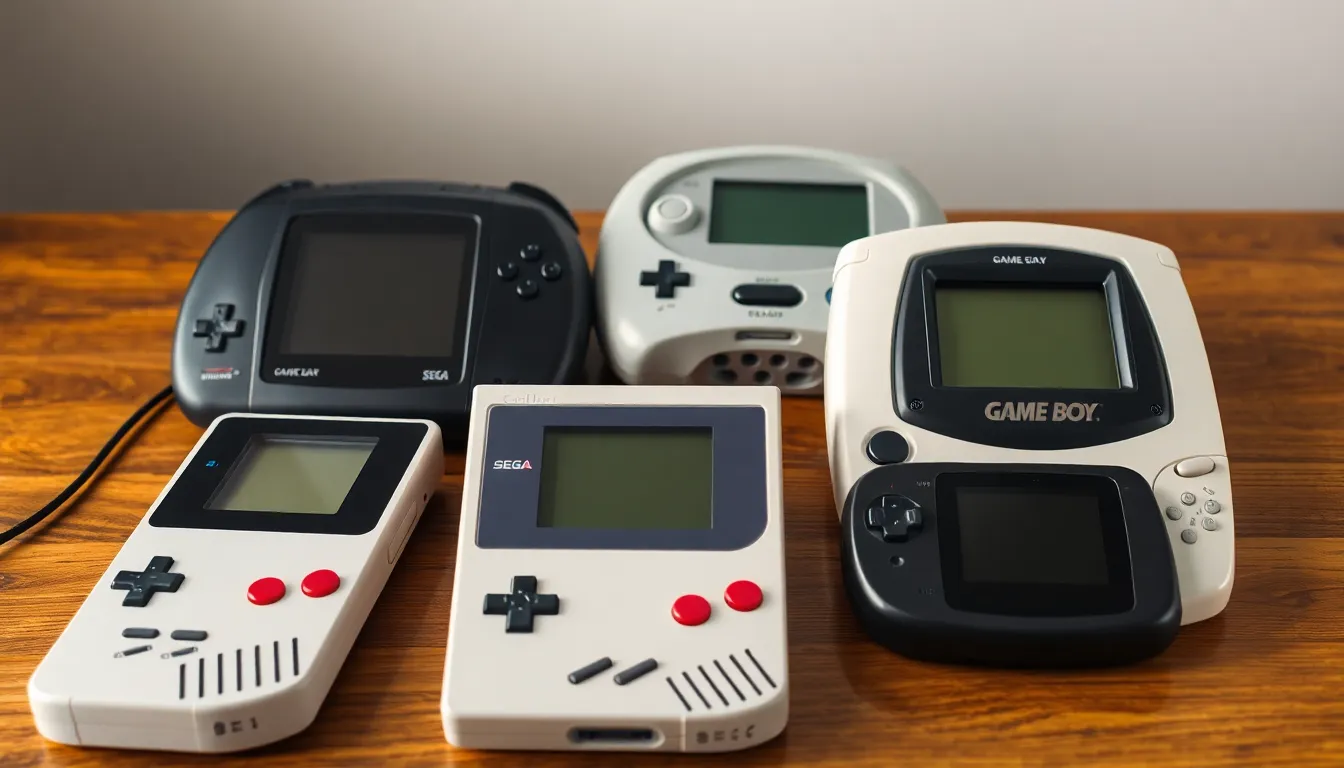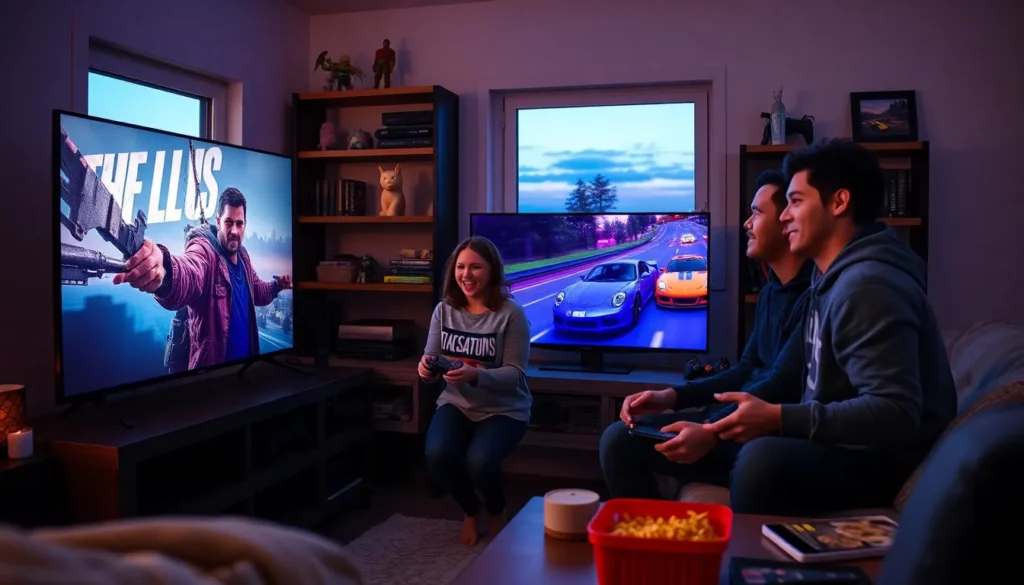Table of Contents
ToggleRemember the thrill of cramming a Game Boy into your pocket, ready to conquer pixelated worlds on the go? Old school portable gaming isn’t just a nostalgic trip down memory lane; it’s a celebration of simpler times when gaming was about skill, not endless updates or in-app purchases.
Overview of Old School Portable Gaming
Old school portable gaming ignites feelings of nostalgia, transporting players to simpler times. This era featured handheld consoles that defined gaming experiences before the emergence of mobile apps and complex systems.
Definition and Timeline
Old school portable gaming encompasses handheld devices designed for gaming on the go. The timeline begins with the release of the original Game Boy in 1989, a pivotal moment in gaming history. Following that, the Atari Lynx hit the market in 1990, showcasing color graphics. In 1998, the Game Boy Color arrived, further enhancing the gaming experience. Other notable devices, such as the Neo Geo Pocket and Sega Game Gear, contributed to the variety available during this period. Each console brought unique features that captivated gamers for decades.
Evolution of Handheld Consoles
The evolution of handheld consoles transformed gaming. Developers prioritized portability, making gaming accessible anywhere. Early consoles, like the Game Boy, emphasized battery life and simple controls for extended play. Subsequently, the rise of 16-bit systems introduced richer graphics and sound. The introduction of backlit screens and multiplayer options in devices like the Nintendo DS expanded gameplay opportunities. By 2004, the Sony PlayStation Portable (PSP) raised the bar with multimedia capabilities. Each innovation shaped the future of portable gaming, laying a foundation for contemporary devices while preserving the charm of old school gaming.
Iconic Handheld Consoles

Old school portable gaming features several iconic handheld consoles that defined the era. Each device contributed uniquely to gaming culture.
Game Boy Series
The Game Boy series revolutionized handheld gaming, starting with its debut in 1989. This system featured a simple yet effective design, appealing to gamers of all ages. Gamers cherished titles like Tetris and Pokémon, which became cultural phenomena. The Game Boy Color, launched in 1998, introduced vibrant graphics and backward compatibility, expanding its library. Players experienced richer visuals and engaging gameplay. The success of the Game Boy series emphasized the importance of portability and accessibility in gaming.
Sega Game Gear
Released in 1990, the Sega Game Gear presented a colorful alternative to the Game Boy. It offered a backlit screen, enabling gameplay in varied lighting conditions. Players explored fast-paced titles like Sonic the Hedgehog and Shinobi, enhancing the gaming experience. The Game Gear’s use of full-color graphics captivated many. Despite its short lifespan, the device built a loyal fan base. It showcased Sega’s commitment to providing a different handheld experience, one that included multimedia capabilities.
Neo Geo Pocket
The Neo Geo Pocket debuted in 1998, targeting hardcore gamers seeking unique experiences. Its compact size made it a convenient option for portable play. Iconic titles like Samurai Shodown and King of Fighters became staples for fans. The device emphasized 2D graphics, delivering well-crafted visuals that appealed to players. Its battery life was impressive, allowing for extended gaming sessions. Although it struggled against competitors, the Neo Geo Pocket earned recognition for its dedication to fighting games and arcade-style action.
Popular Games of the Era
Old school portable gaming featured several iconic titles that defined the experience. Gamers remember the thrill of playing these engaging games during their journeys.
Key Titles That Shaped the Genre
Tetris became a phenomenon with its simple yet addictive gameplay. Pokémon Red and Blue captivated players with creature-catching adventures and intricate battles. Super Mario Land introduced platforming success to handheld consoles with challenging levels. The Legend of Zelda: Link’s Awakening offered an immersive story and exploration, setting a high bar for future titles. Sega’s Sonic the Hedgehog showcased speed and excitement, appealing to a broader audience. Each title contributed significantly to defining portable gaming experiences during that era.
Hidden Gems Worth Exploring
Wario Land: Super Mario Land 3 combined platforming with unique mechanics, allowing players to manipulate the environment creatively. Metroid II: Return of Samus introduced exploration and puzzle-solving elements that expanded the Metroid universe. Kirby’s Dream Land featured a delightful character capable of inhaling enemies to gain their abilities. The Final Fantasy Legend pushed the limits of role-playing games on handhelds, offering deep narratives and character customization. Mastering these titles often offered experiences that surprised dedicated gamers with intricate layers and creative gameplay.
Nostalgia Factor in Old School Portable Gaming
Old school portable gaming evokes strong feelings of nostalgia, connecting players to cherished memories and experiences. Handheld consoles were more than just gaming devices; they represented a freedom to explore unique worlds.
Emotional Attachment to Devices
Players developed personal connections to their devices, making them treasured possessions. The Game Boy, for instance, marked a generation with its timeless design and iconic gray casing. Relationships formed around gaming experiences created lasting bonds, often shared among friends and family. Each handheld console, from the Sega Game Gear to the Neo Geo Pocket, inspired countless hours of gameplay, forging unforgettable memories. These emotional ties generate an undeniable sentimentality, as users reminisce about the joys and challenges they faced.
Cultural Impact on Gaming Community
Old school portable gaming had a significant impact on the gaming community. It fostered a sense of unity among players who shared experiences with beloved titles. Communities formed around games like Pokémon and Tetris, driving conversations and social interactions. Local tournaments and meet-up events grew in popularity as gamers connected through shared interests. Additionally, the innovations from these handheld consoles paved the way for modern gaming trends, influencing design choices and gameplay strategies. The cultural legacy of this era continues to resonate, inspiring new generations of gamers.
Modern Revival of Old School Gaming
The revival of old school gaming experiences resonates strongly with players today. Nostalgia plays a crucial role in this resurgence, especially through retro consoles and emulators.
Retro Consoles and Emulators
Classic consoles receive new life through modern iterations and emulation software. Devices like the Nintendo Switch Online offer access to timeless games, while platforms such as the Analogue Pocket allow gamers to relive their childhood with original cartridges. Emulators provide a way to experience titles from systems like the Game Boy and Sega Genesis on contemporary devices, maintaining the essence of the original experience. Collecting retro consoles appeals to enthusiasts who appreciate the legacy of past technology. Significant sales at auctions for devices like the original Game Boy highlight the ongoing interest in these iconic systems.
Mobile Games Inspired by Classics
Mobile gaming sees a blend of classic design and modern technology. Developers create titles that mimic the charm of old school games, drawing inspiration from beloved franchises. Examples include Pokémon Go, which revitalizes the Pokémon brand with augmented reality elements. Other titles, like Sonic the Hedgehog Classic, capture the essence of their predecessors while fitting seamlessly into smartphones. The integration of retro aesthetics and gameplay mechanics captures a new audience while catering to longtime fans. Accessibility contributes to the popularity of mobile adaptations, allowing widespread enjoyment of classic gaming experiences anytime, anywhere.
Old school portable gaming holds a special place in the hearts of many. The simplicity and charm of handheld consoles like the Game Boy and Sega Game Gear created unforgettable experiences. These devices not only offered a way to escape into pixelated worlds but also fostered connections among friends and family.
As nostalgia drives the revival of classic gaming experiences today, the impact of these early consoles remains evident. Whether through retro consoles or mobile adaptations, the essence of old school gaming continues to inspire new generations. The legacy of these handheld devices proves that great gaming transcends time, offering joy and adventure to all who pick up a controller.







